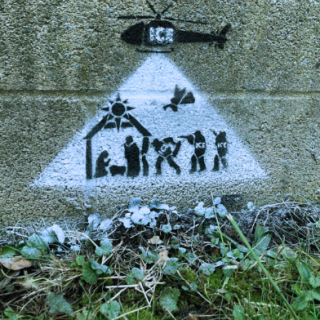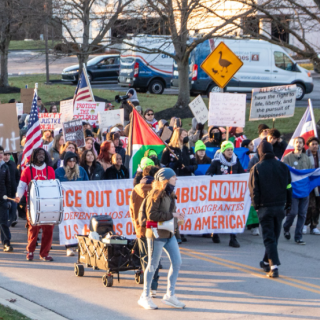Advertisement
A 140-plus year old cemetery lost to time and mostly forgotten could be dug up, built upon, and the remains thrown out, all with help from “Zone In,” says South Side activist and preservationist Bruce Miller.
“There are documents showing slaves who escaped on the underground railroad buried there, plus the least of our brothers and sisters are buried there,” says Miller, president of the Scioto Southland Civic Association. Miller and his mother also sat on the City-affiliated Far South Columbus Area Commission, but both were forced out by City officials for pushing back on “Zone In” – the City’s overhaul of zoning codes so to create more density (taller condos).
The cemetery is roughly several hundred feet off South High (2300 S. High St.) behind the former Rice Bowl restaurant, which closed in 2023. A “Pest House” cemetery is the painful moniker for those who died from communicable diseases, such as tuberculosis, and unable to buy a plot in a church or private cemetery.
After the Rice Bowl was sold, the City required a historic review of the area, and that’s when the City rediscovered its own “Pest Cemetery.” The Rice Bowl was soon demolished, and in its place a much-needed affordable housing development by the South Side faith-focused nonprofit Community Development for All People is nearing completion – but just three feet from the cemetery’s border (pictured above on right).
The cemetery itself, says Miller, is a Zone In parcel. Also on this parcel is the abandoned Fornof Elementary School (156 Dering Avenue), which was built over some graves. How many souls are buried here is unknown. The Ohio History Connection, after using underground penetrating radar, believes the remains of hundreds could still be there.
“This particular parcel could see, I believe, up to 14 stories with the affordable housing bonus,” Miller said.
According to FindaGrave.com, the City of Columbus purchased the land in 1881 to become the “Franklin County Pest House Cemetery.” The county probate court at the time said it was primarily for those who succumbed to smallpox. The cemetery closed in 1903, but the City was unable to sell the property until 1938, and there was no attempt to re-bury the deceased, stated FindaGrave.com.
As drooling developers look to squeeze in density where they can, uncovering forgotten cemeteries is becoming a casual thing of late in Columbus. Taking over the local news cycle like a poltergeist was the 150-year-old North Market parking lot cemetery, where the much anticipated 31-story “The Merchant Building” will rise. A team of archeologists has since removed the remains buried there.
Miller says he and other proud South Siders want the Pest Cemetery’s deceased to be treated with the same dignity, and sooner rather than later, considering the land is for sale. Surveyors with Kentucky license plates have recently been scouring the parcel.
Miller says he raised the issue of the cemetery with City Councilwoman Lourdes Barroso de Padilla and Department of Neighborhoods liaison Katherine Cull.
“I was argued at for bringing this mess forward,” said Miller. “All we are asking is, if they are going to build, relocate any remains found in a dignified manner. Just as they are doing at the North Market parking lot tower site. And some form of historical plaque recognizing the history of the site.”
He continued, “No one at any level can say they were ignorant of this. The Scioto Southland Civic Association has been pushing the city and the county monthly about this. I personally just called Kevin Boyce’s office this past week in my latest round of calls.”
Miller, through the Scioto Southland Civic Association, has asked: Who has been surveying the Pest Cemetery parcel? What developer is interested in buying the cemetery? Weirdly, City officials refuse to say.
Miller’s logic is simple. He wants to ask the potential buyer if they plan on reinterning the deceased who suffered terribly (from smallpox) at the end of their lives?
“The developer is tasked with that [reinterning],” he said. “That’s if the developer agrees. If they don’t, then they dig. If they find something, they can throw it in a dumpster. The State of Ohio Cemetery Board has very loose regulations on abandoned cemeteries.”



